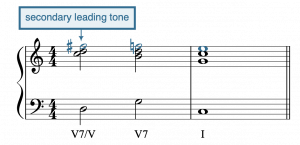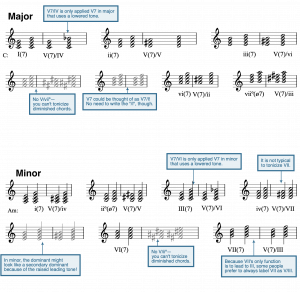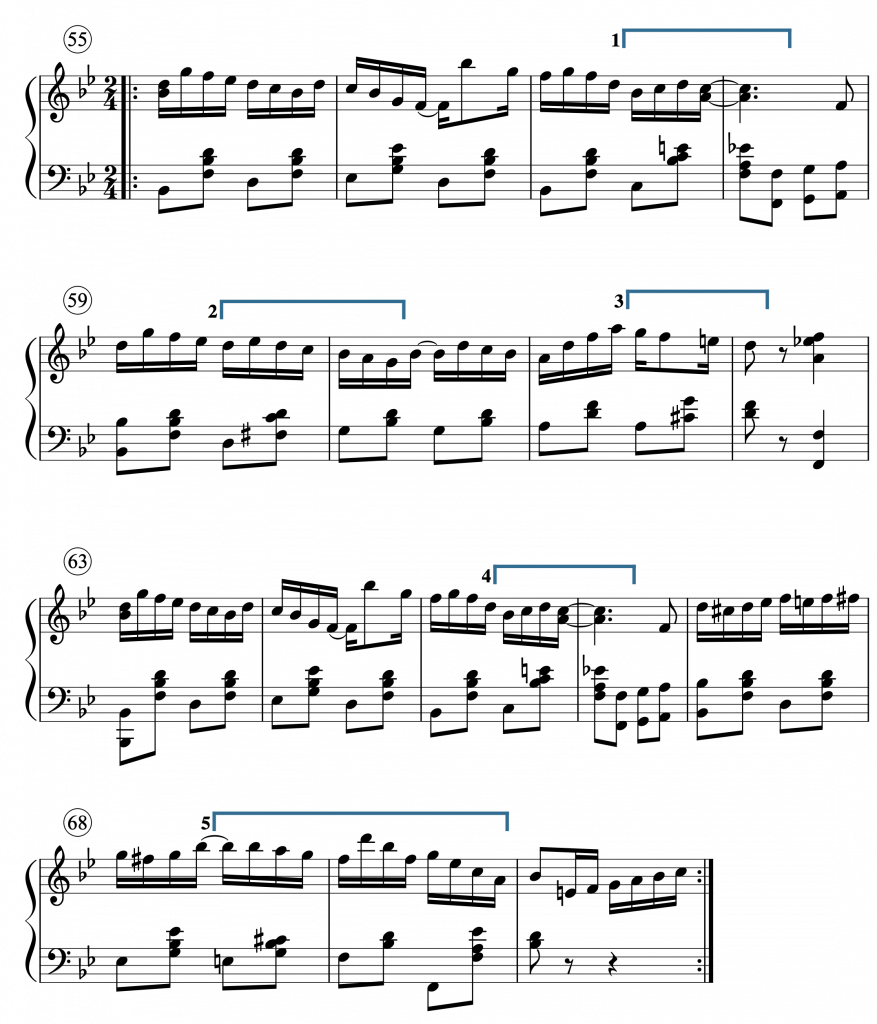scrapyard
Applied chords
Key Takeaways
- Tonicization is the process of momentarily emphasizing a non-tonic chord by using chords borrowed from the key in which that chord is tonic.
- An applied chord (sometimes called a secondary chord) is a dominant chord borrowed from another key. The tonic of this other key is often a diatonic chord within the original key.
- Applied chords can be V, V7, viiº, or viiº7.
- Applied chords are notated with a slash. The chord before the slash is the identity of the applied chord within the secondary key, and the chord after the slash is the chord being tonicized. It’s read aloud left-to-right with the word “of” replacing the slash: V/ii becomes “five of two.”
- Applied chords nearly always involve accidentals, and especially accidentals that raise the pitch.
Applied chords are a category of chromatic harmony, in which a diatonic chord x is embellished with chords from the key of x. For example, in C major, a V chord (G) might be embellished with chords from the key of G major. But unlike modulationthere is no cadence in a new key: only a short progression of chords is borrowed from another key.
Function
The most common applied chords are dominant-function chords: V(7) and viiº(7). The unique quality of these chords (dominant and diminished, respectively) allows them to sound like dominant-function chords even in strange contexts. Example 1 demonstrates this concept: a V7–I progression in one key can be reproduced within a different key. The old I chord, then, is analyzed differently in the new key: for example, as ii, in the bottom staff of Example 1. The old V7 chord is then V7 of ii, written with a slash: V7/ii. The same principle holds with V[latex]\begin{smallmatrix}6\\5\\\end{smallmatrix}[/latex] and other inverted V chords, as shown in the second row of Example 1.
Example 1. Applied chords are dominant-to-tonic progressions that are inserted into a new key.
Spelling and writing applied chords
If you are asked to write an applied chord, follow this process. We will consider a hypothetical applied chord V7/x. x is a substitute for a Roman numeral—it could be V, vi, ii, or any other major or minor Roman numeral—the process is the same regardless of what x is.
Process for spelling V7/x
- Spell x in the current key.
- Identify the root of V in the key of x (a perfect fifth above x, or scale-degree 5 in the key of x).
- Spell a dominant seventh chord built on scale-degree 5 in the key of x.
Here is the above process applied to a concrete example: V7/vi in D major.

1. vi in D major is B minor: B–D–F♯.
2. The root of V in B minor is F♯.
3. The dominant seventh chord built on F♯ is F♯, A♯, C♯, E.
4. V7/vi in B minor is F♯, A♯, C♯, E. Note that the A needs to be raised with an accidental, because it is not in the key signature of D major.
V7 is not the only possible applied chord—viiº is another common type of applied chord. To spell an applied viiº7, follow a slightly different, but related, process.
Process for spelling viiº7/x
- Spell x in the current key.
- Identify the root of viiº7 in the key of x (a minor second below x, or the leading tone of x).
- Spell a fully-diminished seventh chord built on V in the key of x by stacking minor thirds on top of one another.
As a concrete example, Example 3 demonstrates the spelling of viiº7/vi in B minor.

1. vi in D major is B minor: B–D–F♯.
2. The leading tone of B minor, which is the root of viiº7, is A♯.
3. The fully-diminished seventh chord built on A♯ is A♯, C♯, E, G. 4. viiº7/vi in B minor is A♯, C♯, E, G. Note that the A needs to be raised with an accidental, because it is not in the key signature of D major.
Resolving applied chords

The leading tone of the applied chord is referred to as the secondary leading tone; the seventh as the secondary seventh. These dissonances resolve just as they normally would in their own key.
One exception is that when the tonicized chord is itself a seventh chord—as in the progression D7–G7–C—the secondary leading tone may resolve down by semitone into the seventh of the following chord. In the example progression, this would create a nice chromatic line: F♯—F♮—E (Example 4).
Recognizing and identifying applied chords
Applied chords are most easily recognized by their accidentals, especially accidentals that raise the pitch—oftentimes, those raised pitches are secondary leading tones, applied to the tonicized chord. When analyzing the harmonies of a score, you may come to a chord contains raised notes—for example, a chord that looks like ii but is major instead of minor—and suspect that it may be an applied chord. To confirm, skip the chromatic chord and analyze the following chord; then, return to the chromatic chord and see if it is, in fact, an applied chord.
Exercise
Applied V and V7 as altered diatonic chords
Another way of thinking about applied chords is to imagine them as altered versions of the diatonic chord with which it shares a root.
The most straightforward example is when a ii chord is chromatically altered by changing [latex]\hat{4}[/latex] to [latex]\sharp\hat{4}[/latex], and then progresses, like usual, to the dominant chord. This alteration of [latex]\hat{4}[/latex] to [latex]\sharp\hat{4}[/latex] turns a regular subdominant chord into a chord that has a dominant function in the key of the dominant.
Take the chord progression Dmi7–G–C in C major. We would label this progression as ii7–V–I with Roman numerals. If we change [latex]\hat{4}[/latex] (F) to [latex]\sharp\hat{4}[/latex] (F♯) in the Dm chord, we get D7–G–C. In the key of C, we might analyze this progression as II♯7–V–I, noting the change in root and quality. However, we can also note that D major is native to G major; it is a dominant-functioning chord (V) in the key of G—the key in which the following chord is tonic. In other words, we are borrowing the dominant chord from the key of G and applying it to the G-major triad. Thus, we can re-interpret the progression as V7/V–V–I.
Exercise
Example 5 summarizes applied chords as they relate to diatonic chords with the same root.

- Applied chords worksheet A (.pdf, .mscz). Asks students to identify and write applied V, V7, viiº, viiº7, and vii∅7 chords.
- Applied chords worksheet B without ∅7s (.pdf, .mscz). Asks students to identify and write applied V, V7, viiº, and viiº7 chords. Better suited for repertoires that don’t often use applied ∅7s (e.g., jazz and pop).
The process by which a non-tonic triad is made to sound like a temporary tonic. It involves the use of secondary dominant or leading-tone chords.
A category of chords that provides a sense of urgency to resolve toward the tonic chord, including V and vii° (in minor: V and vii°).
1. A scale, mode, or collection that follows the pattern of whole and half steps W–W–H–W–W–W–H, or any rotation of that pattern.
2. Belonging to the local key (as opposed to "chromatic").
A temporary key within a piece that is overall in a different key. For example, a piece in A major may temporarily modulate to E major; E major is a secondary key within A major.
A symbol that alters a pitch, such as the sharp (♯), flat (♭), and natural (♮) symbols.
Relating in some sense to the chromatic scale. The term may be used to refer to notes that are outside the given key.
A change of key.
A 7̂ that is one half step below 1̂. The leading tone is diatonic in major keys, but requires an accidental in minor keys.
A harmonic function that may either lead toward a dominant-function chord or back to a tonic-function chord. Subdominant function is most typically associated with the IV chord, otherwise known as the subdominant chord, and the II chord, otherwise known as the supertonic chord.

